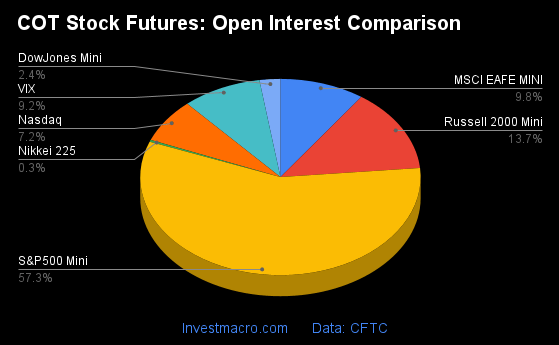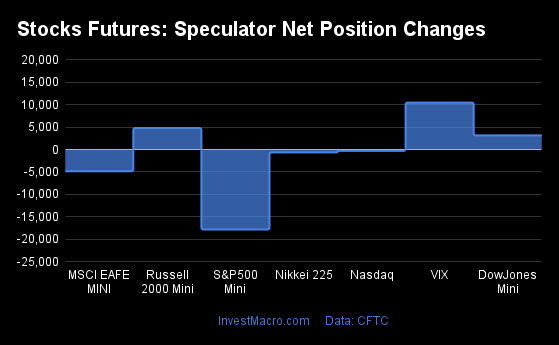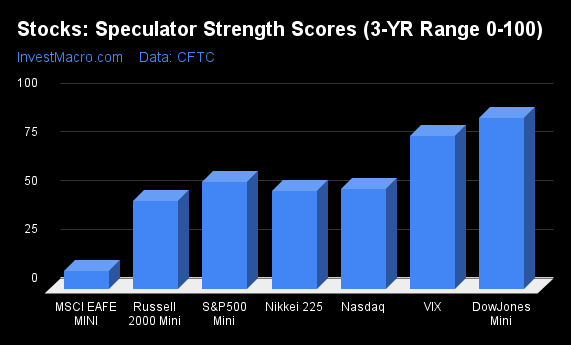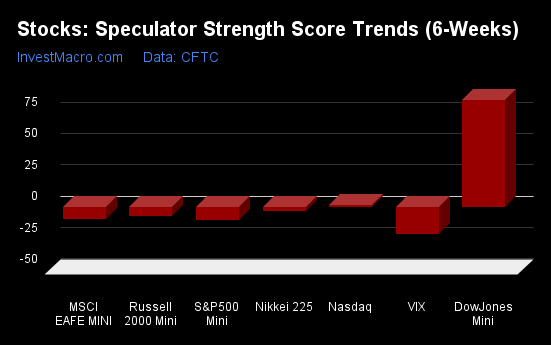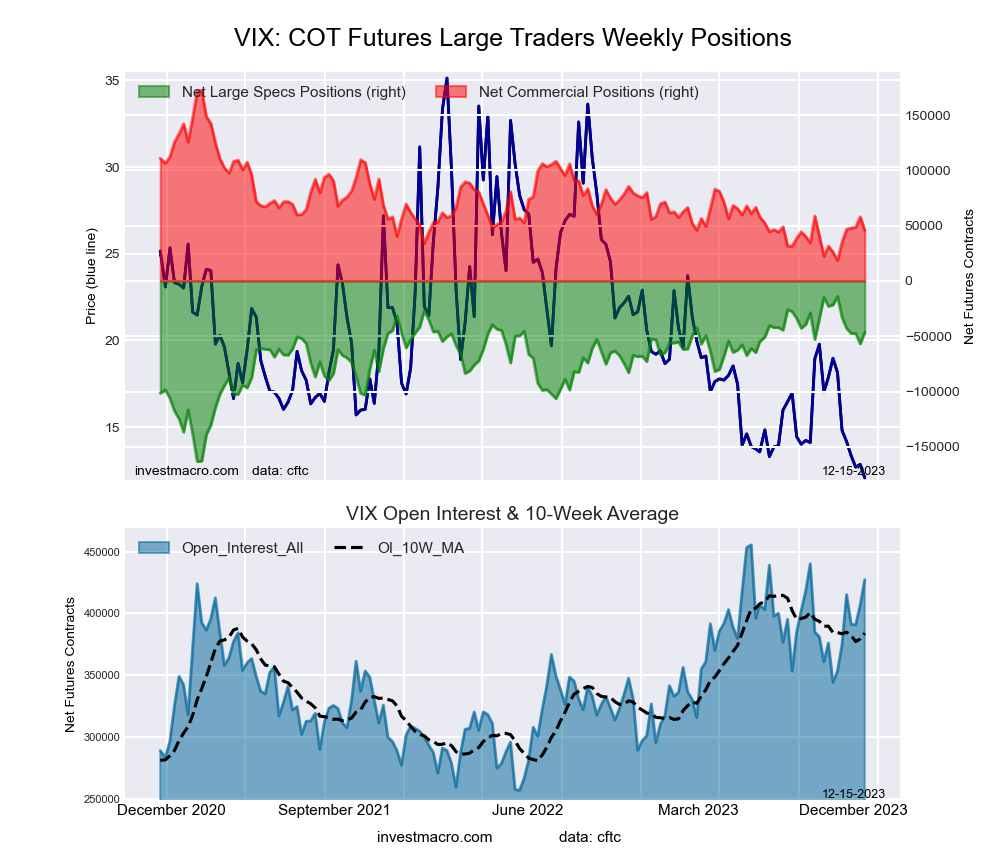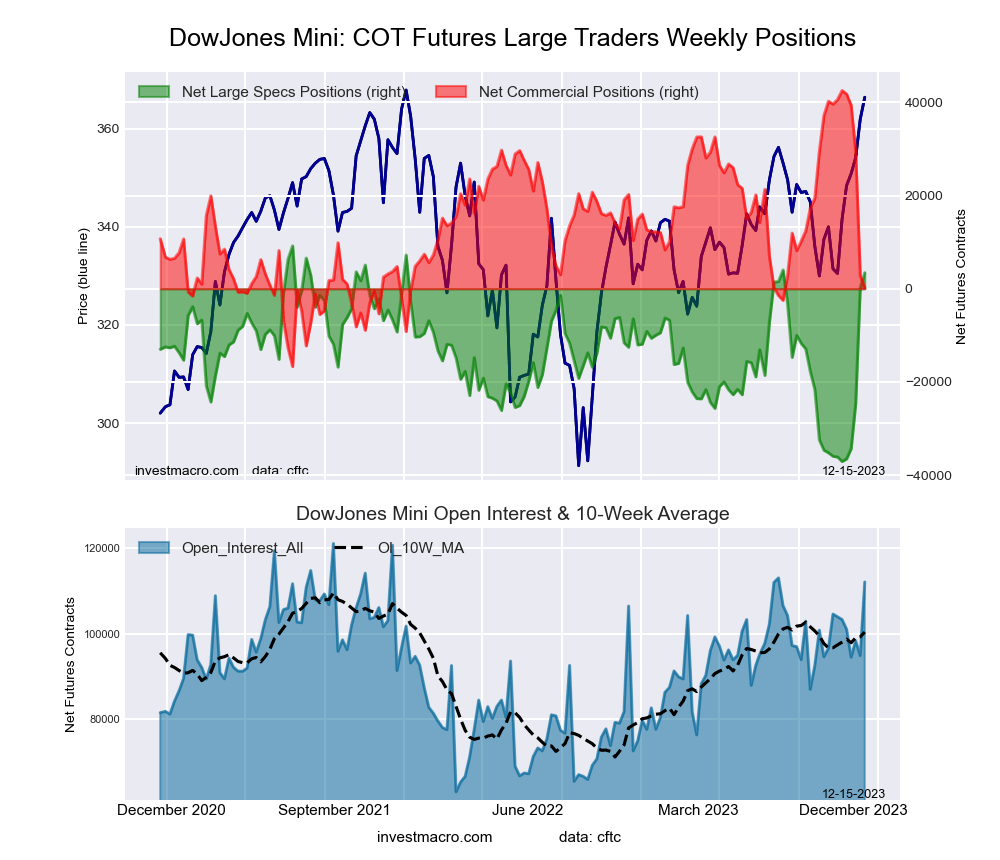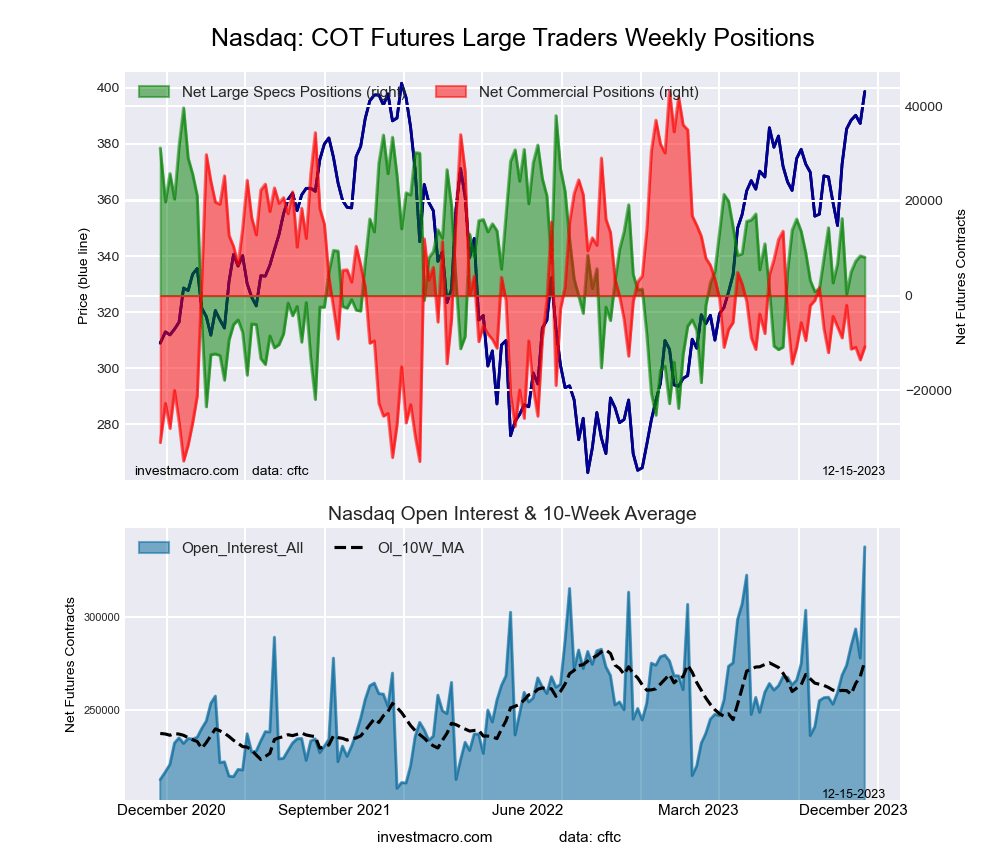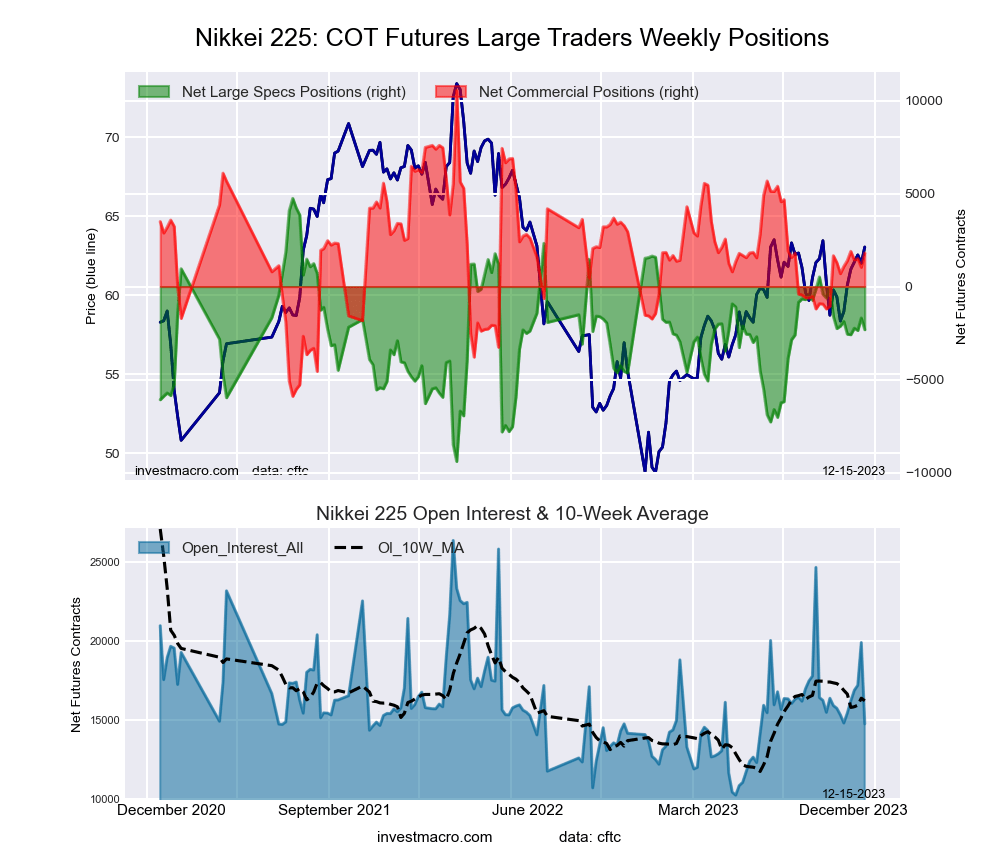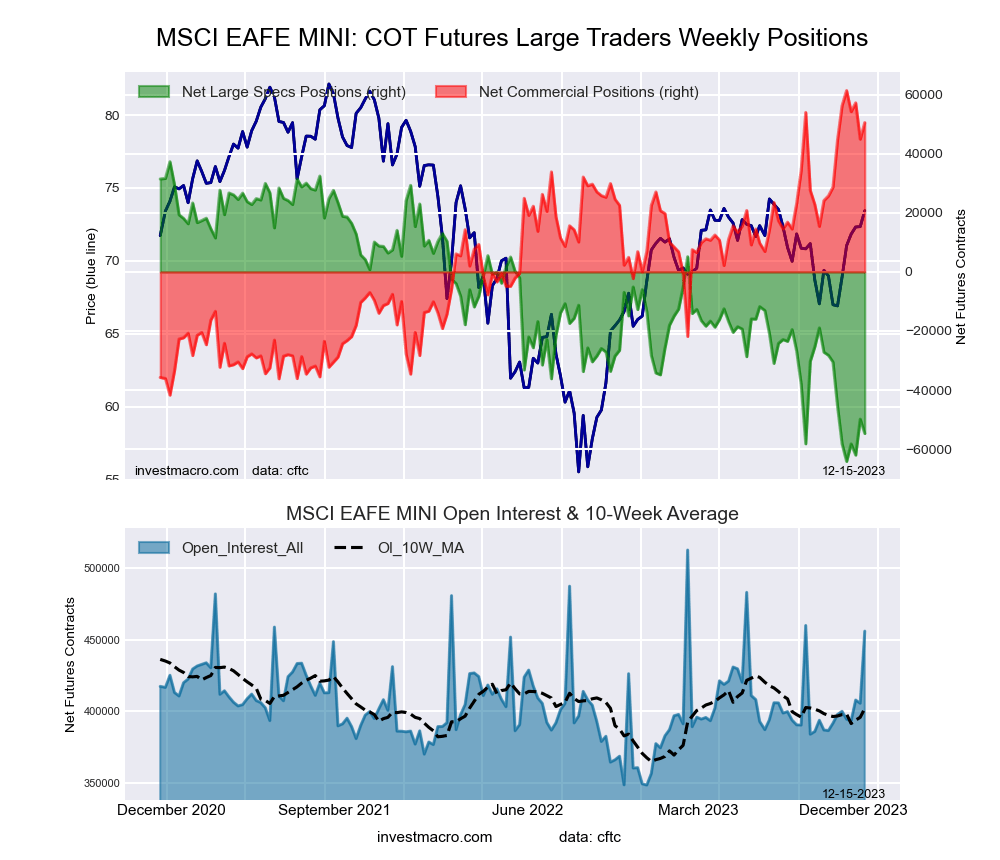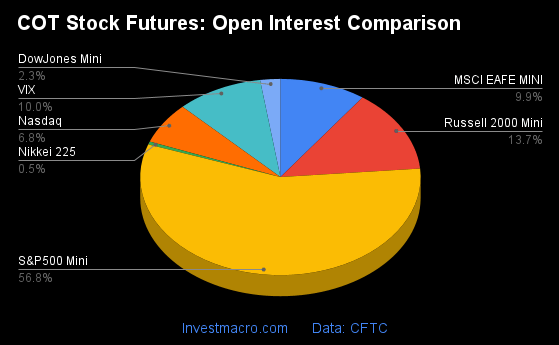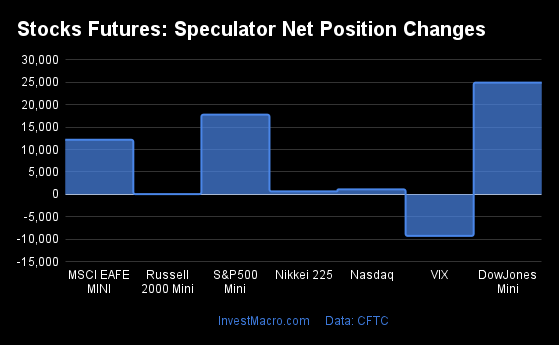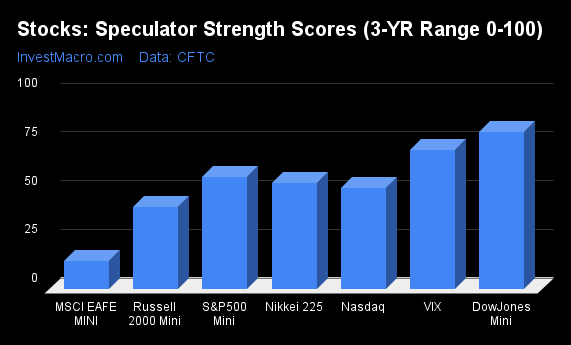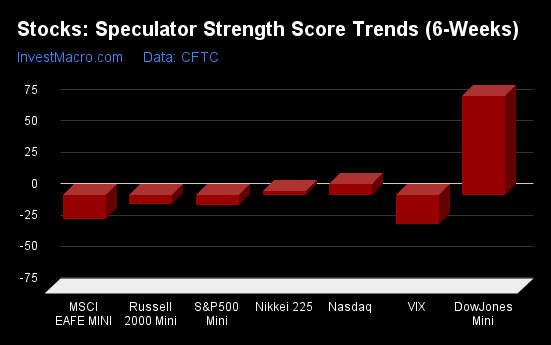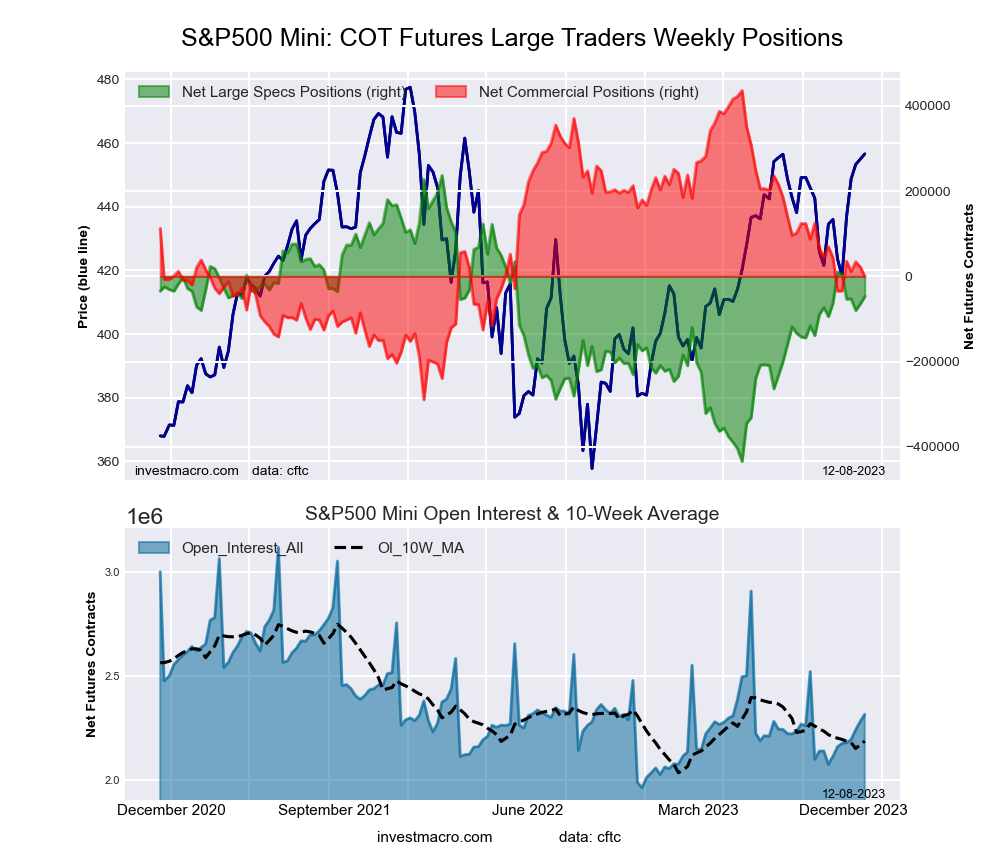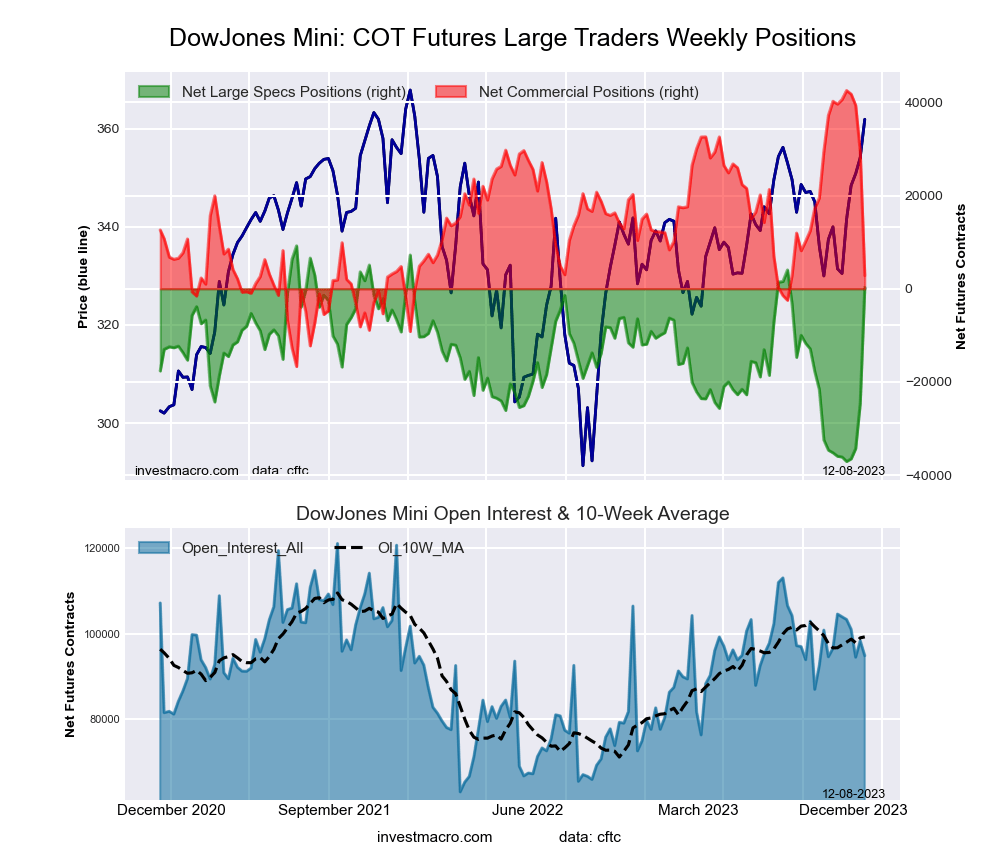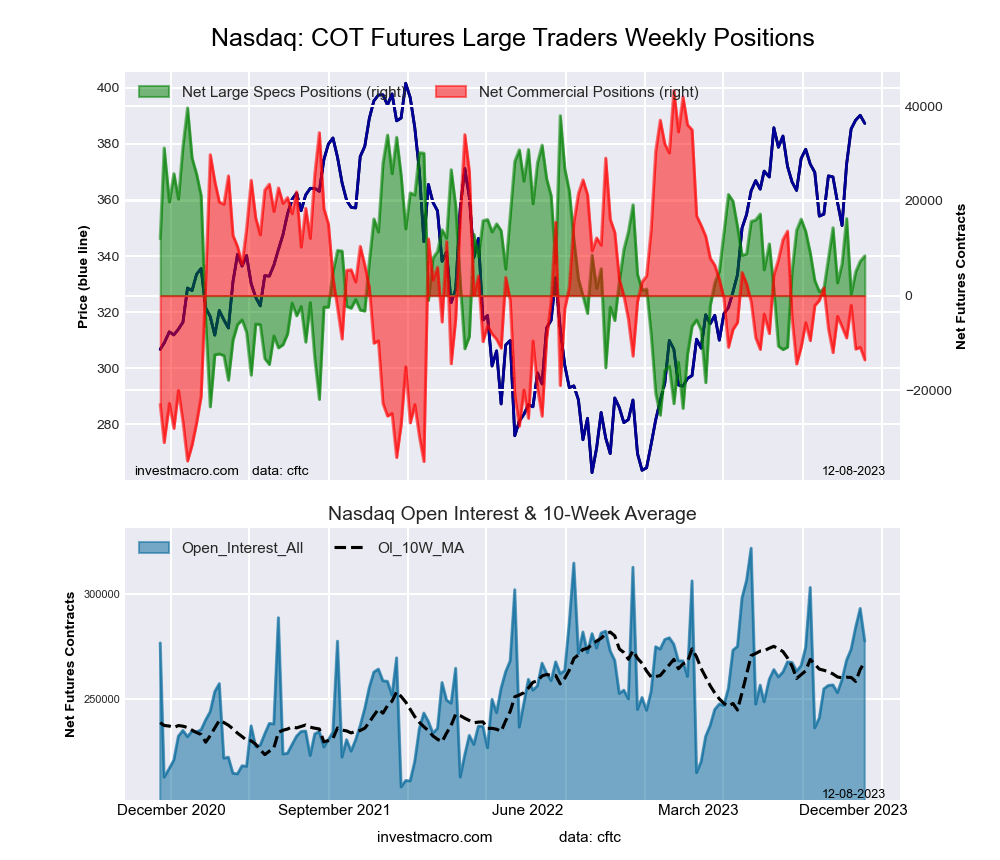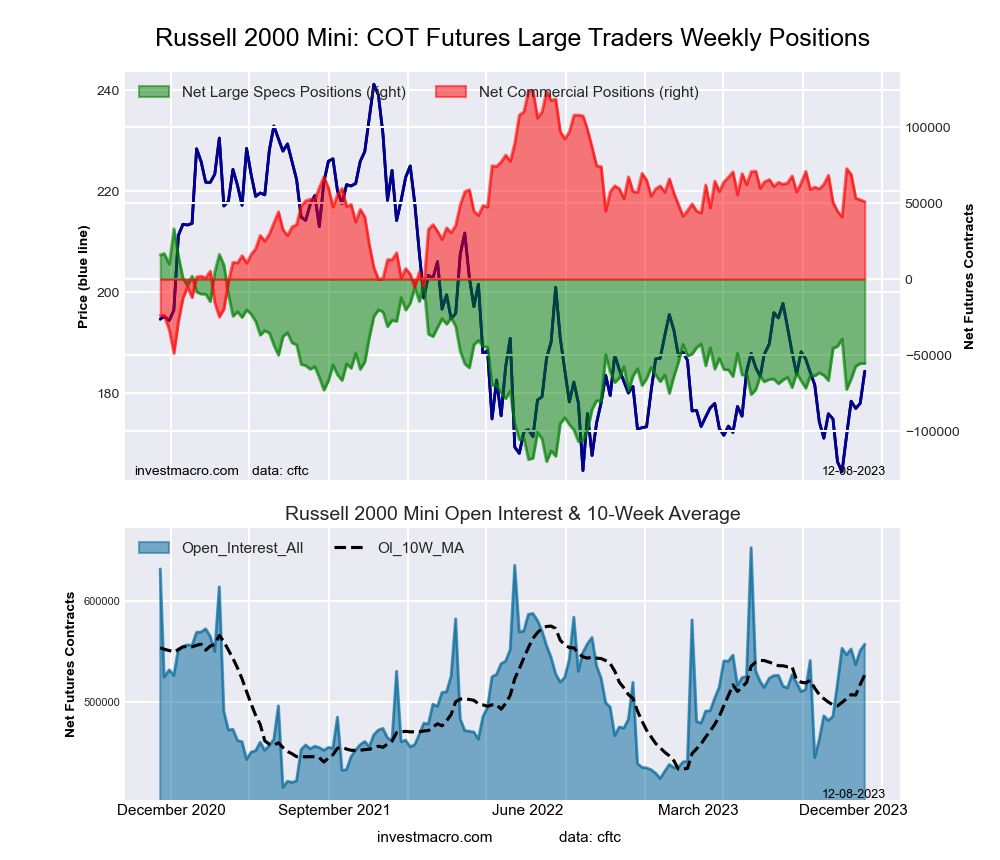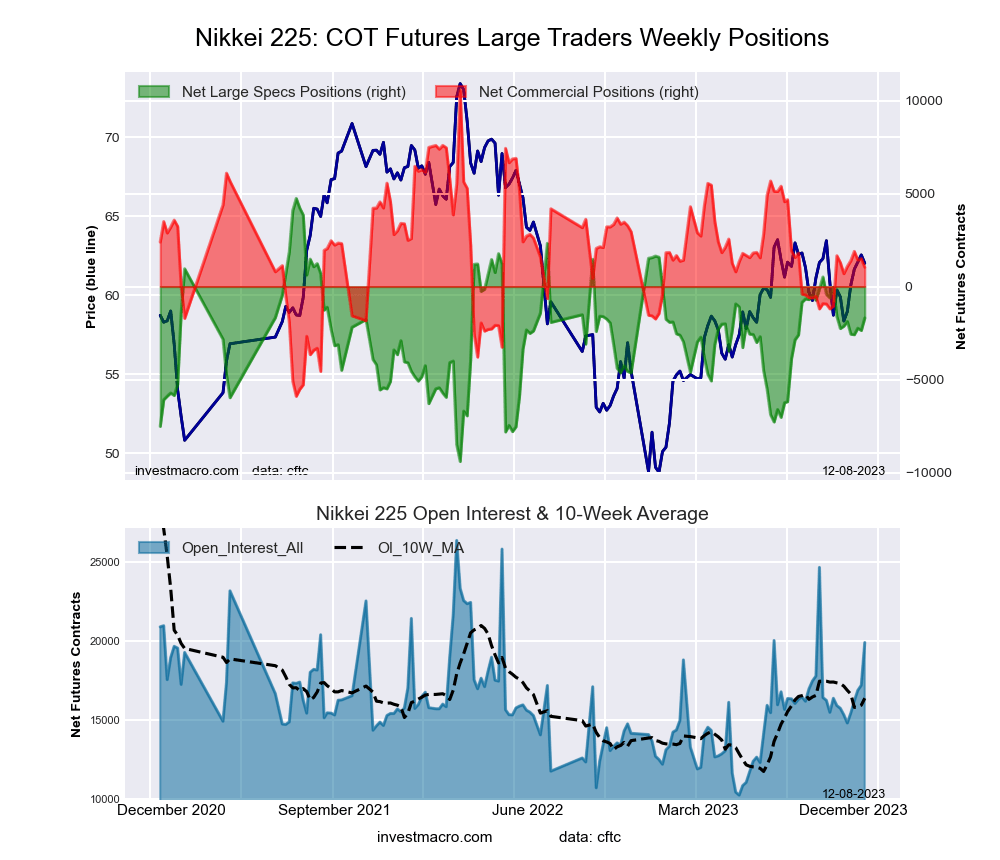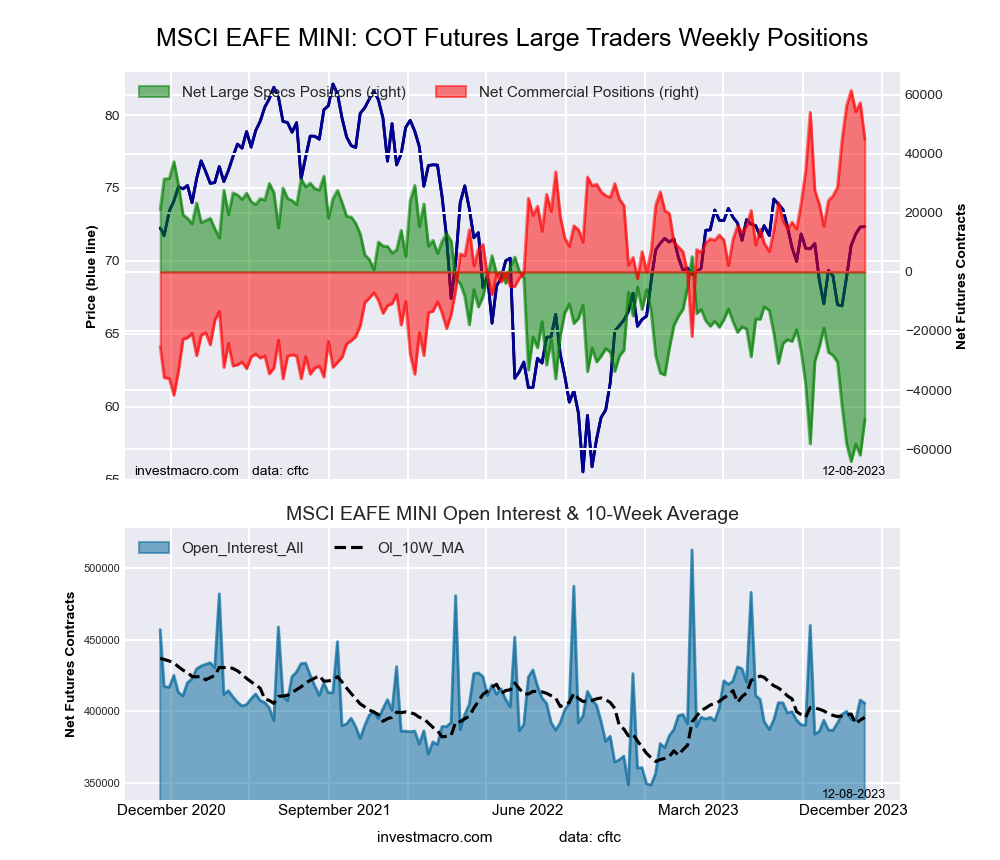By InvestMacro
Here are the latest charts and statistics for the Commitment of Traders (COT) data published by the Commodities Futures Trading Commission (CFTC).
The latest COT data is updated through Tuesday January 9th and shows a quick view of how large traders (for-profit speculators and commercial entities) were positioned in the futures markets.
Weekly Speculator Changes led by S&P500-Mini & Russell-Mini
The COT stock markets speculator bets were higher this week as six out of the seven stock markets we cover had higher positioning while the other one markets had lower speculator contracts.
Leading the gains for the stock markets was the S&P500-Mini with a strong weekly gain by 97,039 contracts. Coming in next was the Russell-Mini (21,933 contracts) with the MSCI EAFE-Mini (7,603 contracts), the DowJones-Mini (4,537 contracts), the VIX (823 contracts) and the Nikkei 225 (762 contracts) also recording positive weekly gains.
The only market with a drop in speculator bets was the Nasdaq-Mini with a decline by -2,291 contracts on the week.
Stock Markets – Speculators Leaderboard
Legend: Weekly Speculators Change | Speculators Current Net Position | Speculators Strength Score compared to last 3-Years (0-100 range)
Strength Scores led by DowJones-Mini & Russell-Mini
COT Strength Scores (a normalized measure of Speculator positions over a 3-Year range, from 0 to 100 where above 80 is Extreme-Bullish and below 20 is Extreme-Bearish) showed that the DowJones-Mini (100 percent) and the Russell-Mini (100 percent) lead the stock markets this week at their top levels of the past three years. The Nasdaq-Mini (96 percent) and VIX (80 percent) come in as the next highest in the weekly strength scores.
On the downside, the MSCI EAFE-Mini (36 percent) comes in at the lowest strength level currently with the next lowest strength score being the S&P500-Mini (47 percent).
Strength Statistics:
VIX (79.8 percent) vs VIX previous week (79.2 percent)
S&P500-Mini (47.3 percent) vs S&P500-Mini previous week (32.8 percent)
DowJones-Mini (100.0 percent) vs DowJones-Mini previous week (92.6 percent)
Nasdaq-Mini (95.6 percent) vs Nasdaq-Mini previous week (99.1 percent)
Russell2000-Mini (100.0 percent) vs Russell2000-Mini previous week (84.4 percent)
Nikkei USD (47.7 percent) vs Nikkei USD previous week (42.3 percent)
EAFE-Mini (36.3 percent) vs EAFE-Mini previous week (28.4 percent)
DowJones-Mini & Russell-Mini top the 6-Week Strength Trends
COT Strength Score Trends (or move index, calculates the 6-week changes in strength scores) showed that the DowJones-Mini (80 percent) leads the past six weeks trends for the stock markets. The Russell-Mini (54 percent), the Nasdaq-Mini (45 percent) and the MSCI EAFE-Mini (34 percent) are the next highest positive movers in the latest trends data.
The S&P500-Mini (-8 percent) leads the downside trend scores currently with the Nikkei USD (-2 percent) coming in as the next market with a lower trend score.
Strength Trend Statistics:
VIX (2.3 percent) vs VIX previous week (1.6 percent)
S&P500-Mini (-7.8 percent) vs S&P500-Mini previous week (-20.0 percent)
DowJones-Mini (79.6 percent) vs DowJones-Mini previous week (88.1 percent)
Nasdaq-Mini (45.4 percent) vs Nasdaq-Mini previous week (52.4 percent)
Russell2000-Mini (54.3 percent) vs Russell2000-Mini previous week (40.0 percent)
Nikkei USD (-2.1 percent) vs Nikkei USD previous week (-8.4 percent)
EAFE-Mini (34.1 percent) vs EAFE-Mini previous week (22.3 percent)
Individual Stock Market Charts:
VIX Volatility Futures:
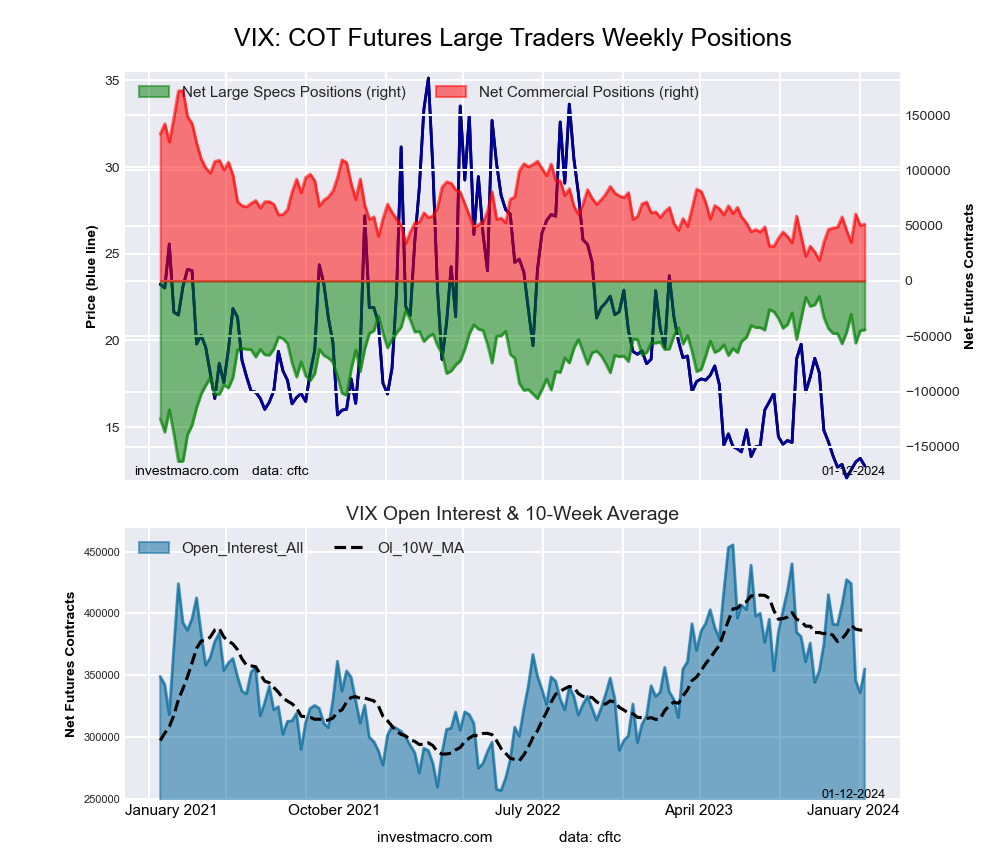 The VIX Volatility large speculator standing this week was a net position of -44,169 contracts in the data reported through Tuesday. This was a weekly gain of 823 contracts from the previous week which had a total of -44,992 net contracts.
The VIX Volatility large speculator standing this week was a net position of -44,169 contracts in the data reported through Tuesday. This was a weekly gain of 823 contracts from the previous week which had a total of -44,992 net contracts.
This week’s current strength score (the trader positioning range over the past three years, measured from 0 to 100) shows the speculators are currently Bullish with a score of 79.8 percent. The commercials are Bearish with a score of 21.2 percent and the small traders (not shown in chart) are Bullish with a score of 60.3 percent.
Price Trend-Following Model: Strong Downtrend
Our weekly trend-following model classifies the current market price position as: Strong Downtrend. The current action for the model is considered to be: Hold – Maintain Short Position.
| VIX Volatility Futures Statistics | SPECULATORS | COMMERCIALS | SMALL TRADERS |
| – Percent of Open Interest Longs: | 19.6 | 48.3 | 7.3 |
| – Percent of Open Interest Shorts: | 32.1 | 33.9 | 9.3 |
| – Net Position: | -44,169 | 51,245 | -7,076 |
| – Gross Longs: | 69,775 | 171,526 | 25,924 |
| – Gross Shorts: | 113,944 | 120,281 | 33,000 |
| – Long to Short Ratio: | 0.6 to 1 | 1.4 to 1 | 0.8 to 1 |
| NET POSITION TREND: | |||
| – Strength Index Score (3 Year Range Pct): | 79.8 | 21.2 | 60.3 |
| – Strength Index Reading (3 Year Range): | Bullish | Bearish | Bullish |
| NET POSITION MOVEMENT INDEX: | |||
| – 6-Week Change in Strength Index: | 2.3 | 1.7 | -30.8 |
S&P500 Mini Futures:
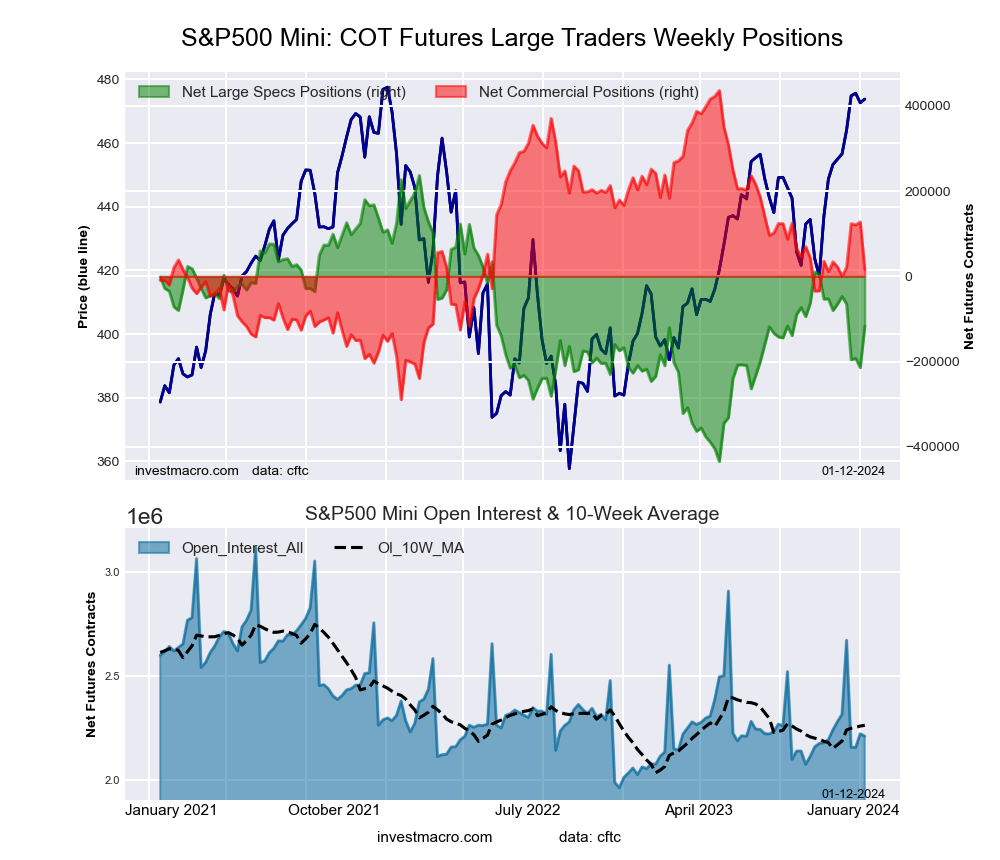 The S&P500 Mini large speculator standing this week was a net position of -117,049 contracts in the data reported through Tuesday. This was a weekly rise of 97,039 contracts from the previous week which had a total of -214,088 net contracts.
The S&P500 Mini large speculator standing this week was a net position of -117,049 contracts in the data reported through Tuesday. This was a weekly rise of 97,039 contracts from the previous week which had a total of -214,088 net contracts.
This week’s current strength score (the trader positioning range over the past three years, measured from 0 to 100) shows the speculators are currently Bearish with a score of 47.3 percent. The commercials are Bearish with a score of 42.0 percent and the small traders (not shown in chart) are Bullish with a score of 77.4 percent.
Price Trend-Following Model: Strong Uptrend
Our weekly trend-following model classifies the current market price position as: Strong Uptrend. The current action for the model is considered to be: Hold – Maintain Long Position.
| S&P500 Mini Futures Statistics | SPECULATORS | COMMERCIALS | SMALL TRADERS |
| – Percent of Open Interest Longs: | 12.3 | 72.5 | 12.6 |
| – Percent of Open Interest Shorts: | 17.6 | 71.8 | 8.0 |
| – Net Position: | -117,049 | 15,495 | 101,554 |
| – Gross Longs: | 272,247 | 1,602,234 | 278,896 |
| – Gross Shorts: | 389,296 | 1,586,739 | 177,342 |
| – Long to Short Ratio: | 0.7 to 1 | 1.0 to 1 | 1.6 to 1 |
| NET POSITION TREND: | |||
| – Strength Index Score (3 Year Range Pct): | 47.3 | 42.0 | 77.4 |
| – Strength Index Reading (3 Year Range): | Bearish | Bearish | Bullish |
| NET POSITION MOVEMENT INDEX: | |||
| – 6-Week Change in Strength Index: | -7.8 | -0.9 | 23.1 |
Dow Jones Mini Futures:
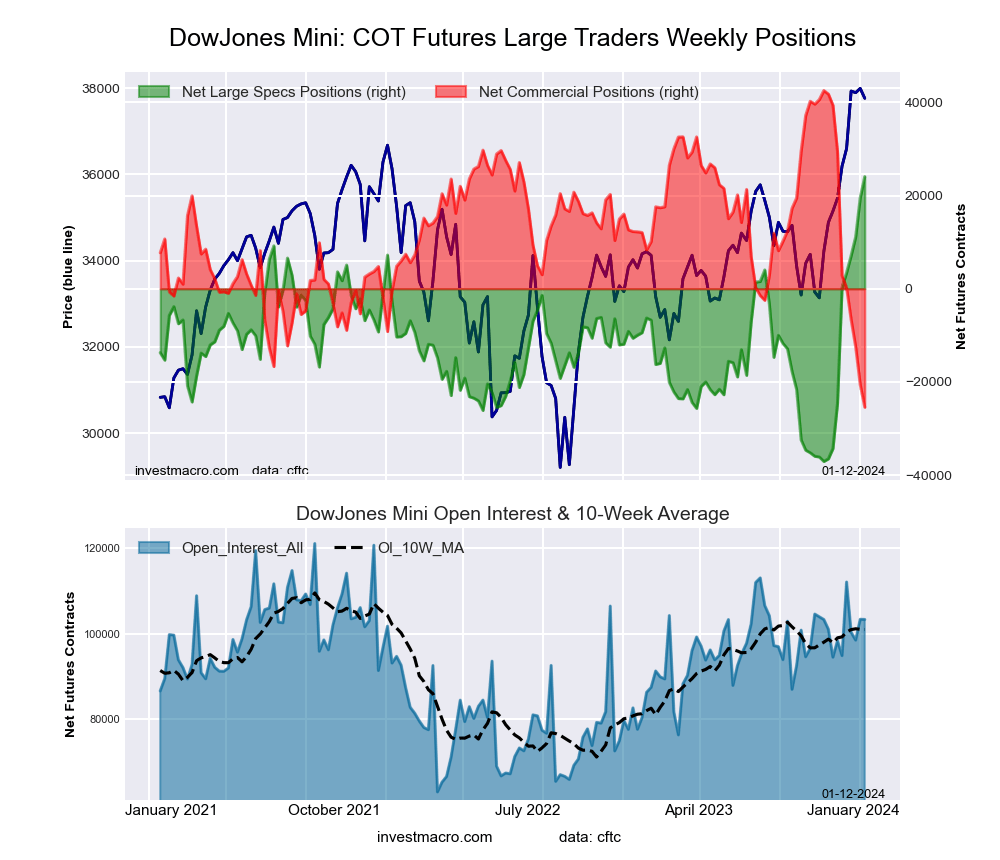 The Dow Jones Mini large speculator standing this week was a net position of 24,079 contracts in the data reported through Tuesday. This was a weekly rise of 4,537 contracts from the previous week which had a total of 19,542 net contracts.
The Dow Jones Mini large speculator standing this week was a net position of 24,079 contracts in the data reported through Tuesday. This was a weekly rise of 4,537 contracts from the previous week which had a total of 19,542 net contracts.
This week’s current strength score (the trader positioning range over the past three years, measured from 0 to 100) shows the speculators are currently Bullish-Extreme with a score of 100.0 percent. The commercials are Bearish-Extreme with a score of 0.0 percent and the small traders (not shown in chart) are Bullish with a score of 50.5 percent.
Price Trend-Following Model: Strong Uptrend
Our weekly trend-following model classifies the current market price position as: Strong Uptrend. The current action for the model is considered to be: Hold – Maintain Long Position.
| Dow Jones Mini Futures Statistics | SPECULATORS | COMMERCIALS | SMALL TRADERS |
| – Percent of Open Interest Longs: | 35.8 | 47.8 | 13.8 |
| – Percent of Open Interest Shorts: | 12.5 | 72.4 | 12.5 |
| – Net Position: | 24,079 | -25,433 | 1,354 |
| – Gross Longs: | 36,987 | 49,419 | 14,256 |
| – Gross Shorts: | 12,908 | 74,852 | 12,902 |
| – Long to Short Ratio: | 2.9 to 1 | 0.7 to 1 | 1.1 to 1 |
| NET POSITION TREND: | |||
| – Strength Index Score (3 Year Range Pct): | 100.0 | 0.0 | 50.5 |
| – Strength Index Reading (3 Year Range): | Bullish-Extreme | Bearish-Extreme | Bullish |
| NET POSITION MOVEMENT INDEX: | |||
| – 6-Week Change in Strength Index: | 79.6 | -80.7 | 30.1 |
Nasdaq Mini Futures:
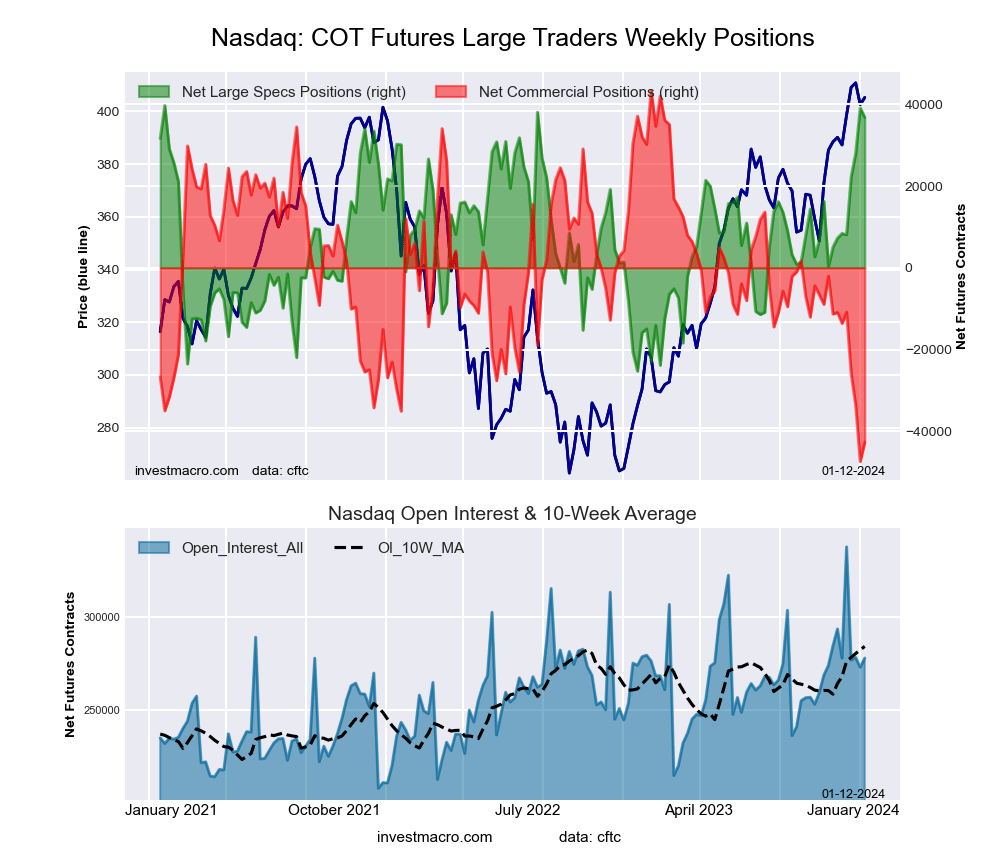 The Nasdaq Mini large speculator standing this week was a net position of 36,776 contracts in the data reported through Tuesday. This was a weekly reduction of -2,291 contracts from the previous week which had a total of 39,067 net contracts.
The Nasdaq Mini large speculator standing this week was a net position of 36,776 contracts in the data reported through Tuesday. This was a weekly reduction of -2,291 contracts from the previous week which had a total of 39,067 net contracts.
This week’s current strength score (the trader positioning range over the past three years, measured from 0 to 100) shows the speculators are currently Bullish-Extreme with a score of 95.6 percent. The commercials are Bearish-Extreme with a score of 5.2 percent and the small traders (not shown in chart) are Bullish-Extreme with a score of 93.4 percent.
Price Trend-Following Model: Strong Uptrend
Our weekly trend-following model classifies the current market price position as: Strong Uptrend. The current action for the model is considered to be: Hold – Maintain Long Position.
| Nasdaq Mini Futures Statistics | SPECULATORS | COMMERCIALS | SMALL TRADERS |
| – Percent of Open Interest Longs: | 29.9 | 54.2 | 15.1 |
| – Percent of Open Interest Shorts: | 16.7 | 69.6 | 13.0 |
| – Net Position: | 36,776 | -42,601 | 5,825 |
| – Gross Longs: | 83,021 | 150,591 | 42,040 |
| – Gross Shorts: | 46,245 | 193,192 | 36,215 |
| – Long to Short Ratio: | 1.8 to 1 | 0.8 to 1 | 1.2 to 1 |
| NET POSITION TREND: | |||
| – Strength Index Score (3 Year Range Pct): | 95.6 | 5.2 | 93.4 |
| – Strength Index Reading (3 Year Range): | Bullish-Extreme | Bearish-Extreme | Bullish-Extreme |
| NET POSITION MOVEMENT INDEX: | |||
| – 6-Week Change in Strength Index: | 45.4 | -35.0 | 6.0 |
Russell 2000 Mini Futures:
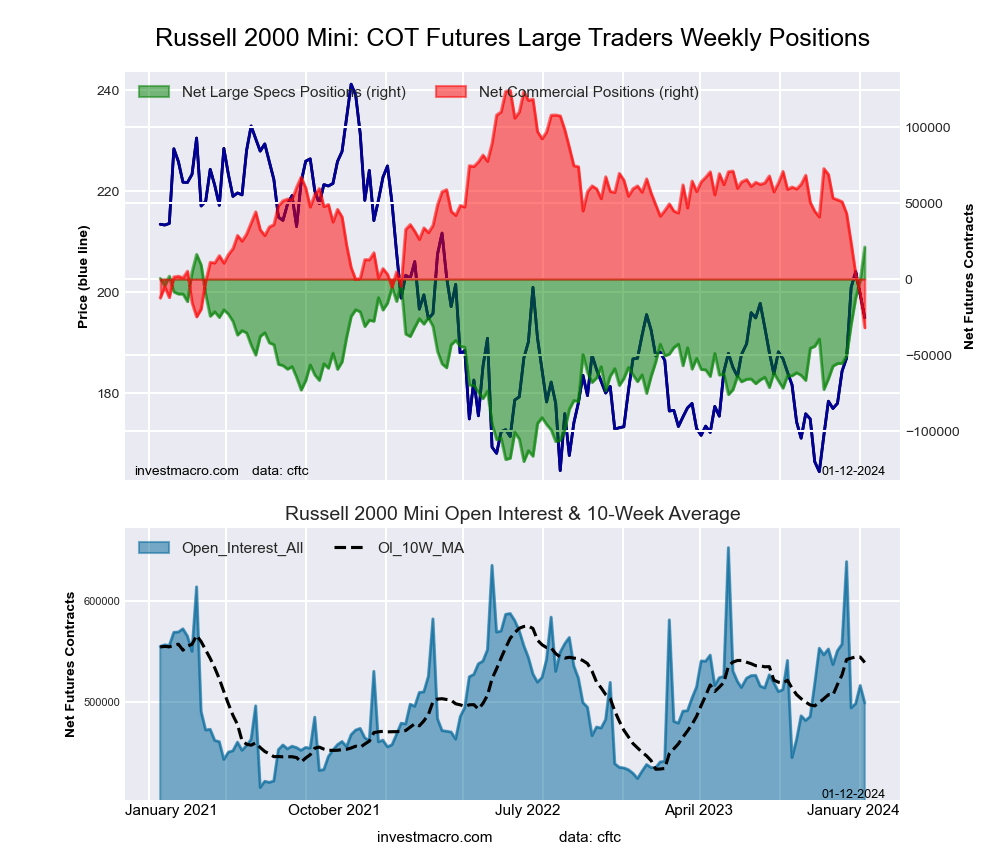 The Russell 2000 Mini large speculator standing this week was a net position of 21,012 contracts in the data reported through Tuesday. This was a weekly gain of 21,933 contracts from the previous week which had a total of -921 net contracts.
The Russell 2000 Mini large speculator standing this week was a net position of 21,012 contracts in the data reported through Tuesday. This was a weekly gain of 21,933 contracts from the previous week which had a total of -921 net contracts.
This week’s current strength score (the trader positioning range over the past three years, measured from 0 to 100) shows the speculators are currently Bullish-Extreme with a score of 100.0 percent. The commercials are Bearish-Extreme with a score of 0.0 percent and the small traders (not shown in chart) are Bullish with a score of 65.9 percent.
Price Trend-Following Model: Strong Uptrend
Our weekly trend-following model classifies the current market price position as: Strong Uptrend. The current action for the model is considered to be: Hold – Maintain Long Position.
| Russell 2000 Mini Futures Statistics | SPECULATORS | COMMERCIALS | SMALL TRADERS |
| – Percent of Open Interest Longs: | 19.0 | 74.3 | 6.0 |
| – Percent of Open Interest Shorts: | 14.8 | 80.7 | 3.8 |
| – Net Position: | 21,012 | -31,976 | 10,964 |
| – Gross Longs: | 94,710 | 370,642 | 30,111 |
| – Gross Shorts: | 73,698 | 402,618 | 19,147 |
| – Long to Short Ratio: | 1.3 to 1 | 0.9 to 1 | 1.6 to 1 |
| NET POSITION TREND: | |||
| – Strength Index Score (3 Year Range Pct): | 100.0 | 0.0 | 65.9 |
| – Strength Index Reading (3 Year Range): | Bullish-Extreme | Bearish-Extreme | Bullish |
| NET POSITION MOVEMENT INDEX: | |||
| – 6-Week Change in Strength Index: | 54.3 | -53.9 | 25.7 |
Nikkei Stock Average (USD) Futures:
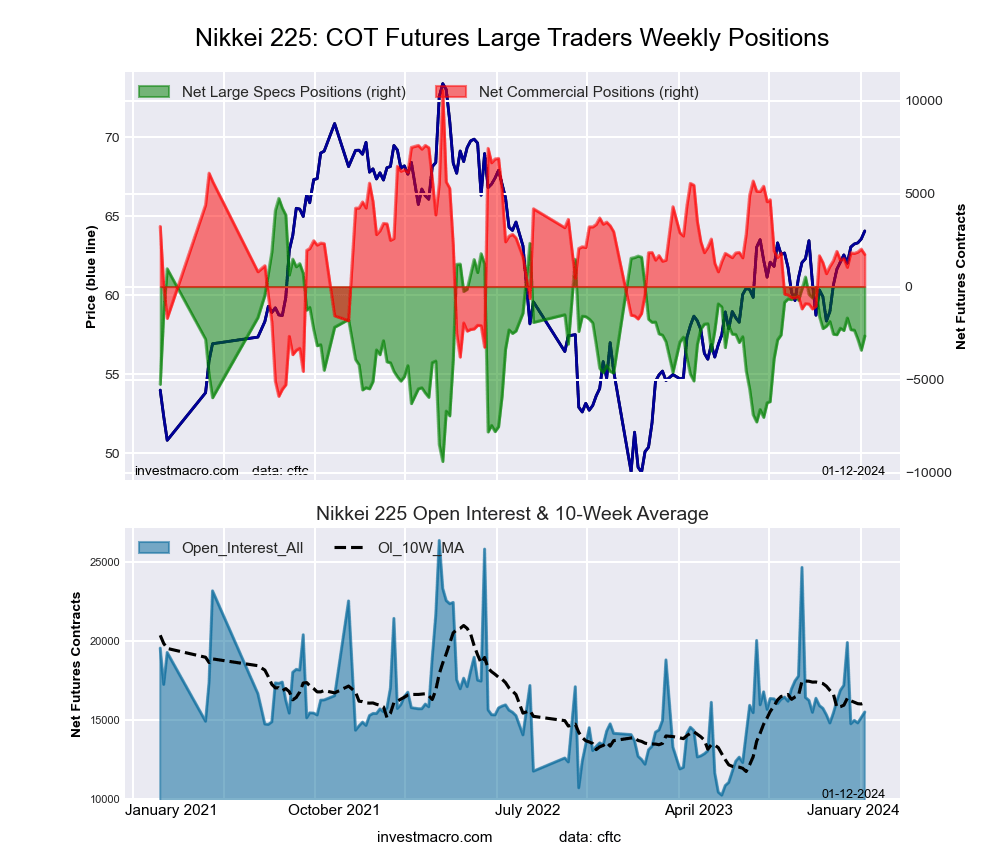 The Nikkei Stock Average (USD) large speculator standing this week was a net position of -2,658 contracts in the data reported through Tuesday. This was a weekly lift of 762 contracts from the previous week which had a total of -3,420 net contracts.
The Nikkei Stock Average (USD) large speculator standing this week was a net position of -2,658 contracts in the data reported through Tuesday. This was a weekly lift of 762 contracts from the previous week which had a total of -3,420 net contracts.
This week’s current strength score (the trader positioning range over the past three years, measured from 0 to 100) shows the speculators are currently Bearish with a score of 47.7 percent. The commercials are Bearish with a score of 46.4 percent and the small traders (not shown in chart) are Bullish with a score of 52.2 percent.
Price Trend-Following Model: Strong Uptrend
Our weekly trend-following model classifies the current market price position as: Strong Uptrend. The current action for the model is considered to be: Hold – Maintain Long Position.
| Nikkei Stock Average Futures Statistics | SPECULATORS | COMMERCIALS | SMALL TRADERS |
| – Percent of Open Interest Longs: | 11.7 | 64.4 | 23.9 |
| – Percent of Open Interest Shorts: | 28.8 | 53.3 | 17.9 |
| – Net Position: | -2,658 | 1,724 | 934 |
| – Gross Longs: | 1,811 | 9,991 | 3,702 |
| – Gross Shorts: | 4,469 | 8,267 | 2,768 |
| – Long to Short Ratio: | 0.4 to 1 | 1.2 to 1 | 1.3 to 1 |
| NET POSITION TREND: | |||
| – Strength Index Score (3 Year Range Pct): | 47.7 | 46.4 | 52.2 |
| – Strength Index Reading (3 Year Range): | Bearish | Bearish | Bullish |
| NET POSITION MOVEMENT INDEX: | |||
| – 6-Week Change in Strength Index: | -2.1 | 1.3 | 1.3 |
MSCI EAFE Mini Futures:
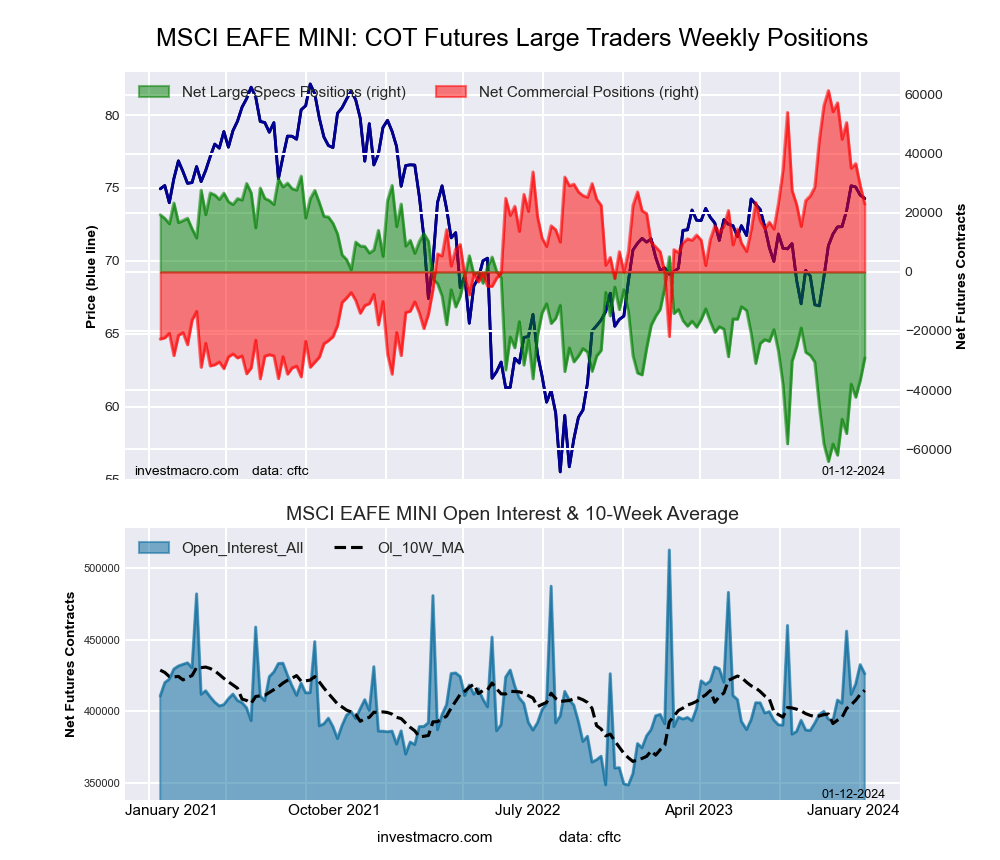 The MSCI EAFE Mini large speculator standing this week was a net position of -29,126 contracts in the data reported through Tuesday. This was a weekly gain of 7,603 contracts from the previous week which had a total of -36,729 net contracts.
The MSCI EAFE Mini large speculator standing this week was a net position of -29,126 contracts in the data reported through Tuesday. This was a weekly gain of 7,603 contracts from the previous week which had a total of -36,729 net contracts.
This week’s current strength score (the trader positioning range over the past three years, measured from 0 to 100) shows the speculators are currently Bearish with a score of 36.3 percent. The commercials are Bullish with a score of 60.6 percent and the small traders (not shown in chart) are Bearish with a score of 47.7 percent.
Price Trend-Following Model: Strong Uptrend
Our weekly trend-following model classifies the current market price position as: Strong Uptrend. The current action for the model is considered to be: Hold – Maintain Long Position.
| MSCI EAFE Mini Futures Statistics | SPECULATORS | COMMERCIALS | SMALL TRADERS |
| – Percent of Open Interest Longs: | 7.1 | 89.0 | 3.6 |
| – Percent of Open Interest Shorts: | 13.9 | 83.6 | 2.2 |
| – Net Position: | -29,126 | 22,977 | 6,149 |
| – Gross Longs: | 30,146 | 379,373 | 15,395 |
| – Gross Shorts: | 59,272 | 356,396 | 9,246 |
| – Long to Short Ratio: | 0.5 to 1 | 1.1 to 1 | 1.7 to 1 |
| NET POSITION TREND: | |||
| – Strength Index Score (3 Year Range Pct): | 36.3 | 60.6 | 47.7 |
| – Strength Index Reading (3 Year Range): | Bearish | Bullish | Bearish |
| NET POSITION MOVEMENT INDEX: | |||
| – 6-Week Change in Strength Index: | 34.1 | -35.1 | 6.8 |
Article By InvestMacro – Receive our weekly COT Newsletter
*COT Report: The COT data, released weekly to the public each Friday, is updated through the most recent Tuesday (data is 3 days old) and shows a quick view of how large speculators or non-commercials (for-profit traders) were positioned in the futures markets.
The CFTC categorizes trader positions according to commercial hedgers (traders who use futures contracts for hedging as part of the business), non-commercials (large traders who speculate to realize trading profits) and nonreportable traders (usually small traders/speculators) as well as their open interest (contracts open in the market at time of reporting). See CFTC criteria here.

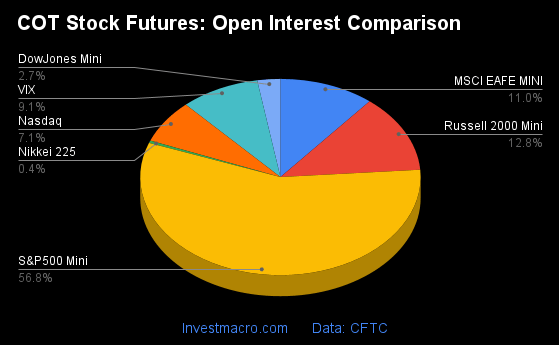
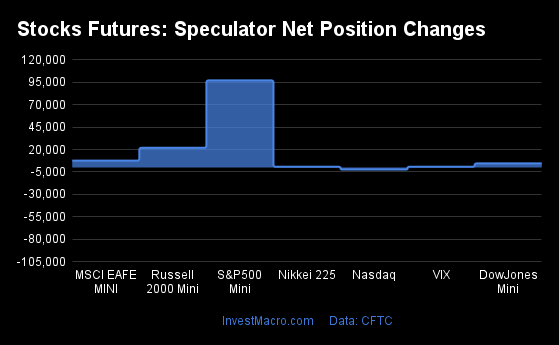
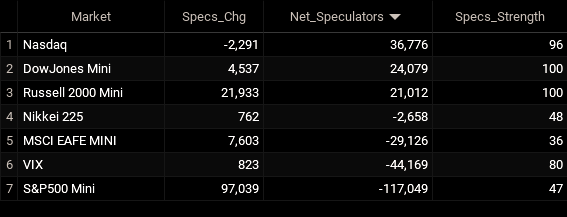
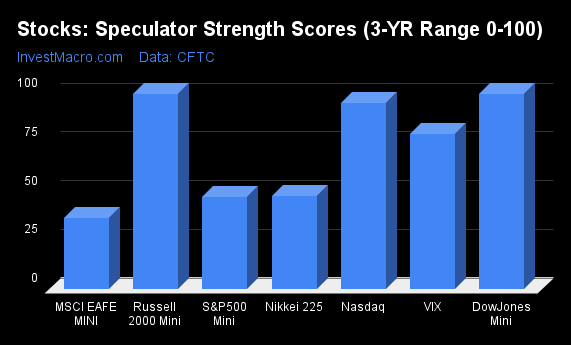
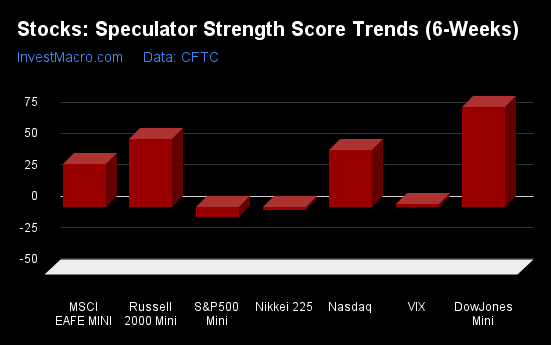


 Article by
Article by 



 Dans un contexte d’augmentation des risques psychosociaux, ignorer les émotions au travail n’aide pas…
Dans un contexte d’augmentation des risques psychosociaux, ignorer les émotions au travail n’aide pas…